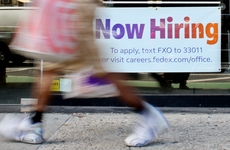Worried about a potential recession? Here’s 9 steps to prepare your finances now

The Bankrate promise
At Bankrate we strive to help you make smarter financial decisions. While we adhere to strict , this post may contain references to products from our partners. Here's an explanation for .
The U.S. economy has seemingly stood its ground against the hottest inflation and most aggressively hawkish Federal Reserve in 40 years — but that might not last forever.
Recessions are inevitable in any economic cycle, but they’re even more likely when U.S. central bankers are actively taking steam away from the financial system. Fed officials have raised interest rates in the quickest span since the 1980s, pushing them in March to a new target range of 4.75-5 percent after holding at near-zero just one year earlier.
Experts say the Fed likely has one more interest rate hike left, but a Fed on pause won’t keep the economy from continuing to slow. Each rate decision spreads throughout the financial system with a delay, sometimes taking up to a full year, if not more, to impact hiring and inflation — or in this case, push an economy into a recession. The U.S. economy has a 64 percent chance of contracting by the end of 2023, according to the nation’s top economists in Bankrate’s First-Quarter Economic Indicator survey.
Recession risks have been regarded as elevated for many months now. Those risks are seen inflamed by recent bank failures, financial instability and tightening of credit. What isn’t known is how much these hikes might hurt the job market in future months, and, by extension, Americans’ personal finances.— Mark Hamrick, Bankrate senior economic analyst
Only economists on the National Bureau of Economic Research’s Business Cycle Dating Committee can declare when U.S. recessions start and end. Yet, economists often make that call more than a year after the recession has already begun. It underscores just how important it is to prepare your finances for a downturn long before any tough economic time occurs. Even better, Americans can leverage stronger economic times to button up their finances for the tougher times that inevitably always lie ahead.
Recessions often take away Americans’ comfort in the economy, leading to poor-performing investments, falling asset values, reduced job security, — or worse, job loss. Here are 9 steps to prepare your money for a recession and the devastating consequences that come along with it.
Key insights on recessions:
- A recession is more nuanced than that textbook definition you’ve often heard. The Business Cycle Dating Committee’s official definition claims that a recession is a significant decline in economic activity across the financial system for longer than a few months. Economic growth can decline for two straight quarters, but not always.
- Is the U.S. economy in a recession? The National Bureau of Economic Research’s Business Cycle Dating Committee hasn’t yet declared one, but economists are divided. While economic growth shrank for two straight quarters at the start of 2022, growth has since picked up, spending has remained relatively strong and hiring has boomed despite higher interest rates and soaring inflation.
- Even if the U.S. economy isn’t in a recession, Americans can still feel like they’re living through tough times — because they are. More than half (or 55 percent) of Americans who scored a raise between August 2021 and August 2022 said their income hasn’t kept up with inflation, a feeling akin to taking a pay cut.
- Preparing for a recession comes down to using strong economic times to your benefit. Focus on limiting your spending, forming a budget, building an emergency fund and eliminating high-interest debts.
- The U.S. economy has a 64 percent chance of contracting by the end of 2023, according to the nation’s top economists in Bankrate’s First-Quarter Economic Indicator survey.
- Recession worries are on Americans’ minds. Nearly 7 in 10 Americans (69 percent) say they’re worried about the possibility of a recession before the end of 2023, with 29 percent saying they’re very worried and another 40 percent saying they’re somewhat worried.
1. Take a detailed stock of your finances
One of the most common unexpected expenses during a downturn is job loss. And when times are tough, companies may scale back on hiring and slash jobs. The job market could have 252,000 fewer jobs by March 2023, with employers projected to cut jobs as the year unfolds, according to economists’ projections in Bankrate’s First-Quarter Economic Indicator poll.
It all means your income could get disrupted in a recession, and you might not know how long you’ll be unemployed.
Those worries are already on Americans’ minds. A third (or 33 percent) are worried about their job security, while more than two-thirds (or 68 percent) of people are worried they wouldn’t be able to cover their living expenses for just one month if they lost their primary source of income.
If you’re worried about a recession, your first step should be opening up all your accounts and getting a complete picture of your finances. Write down every financial firm you regularly work with, whom you regularly pay a bill to and how much it is. See how much cash you have available right now, whether in a checking or savings account. Find out the categories where you spend money most.
It’s always a good idea to go through your monthly expenses and identify which items are discretionary — services or items you can live without — and which items are a necessity. Consider also tracking your pay stubs, so you know how much money you have coming in each month.
Taking a hard look at your finances helps you know who to contact if you face a tough financial situation. Credit card companies, banks and even utility companies created programs during the coronavirus pandemic that helped cash-strapped Americans keep their lights on even when they struggled to pay their bills with special forbearance programs.
The other reason a financial inventory could benefit you is that you’ll be able to quickly identify which expenses can be cut. That subscription service you forgot to cancel? That premium app you use sometimes, but not often? If you’re in a pinch or trying to raise cash, it might be time to cancel.
2. Make building an emergency fund your top priority
The job market uncertainty highlights one of the key pillars of any financial plan: having an emergency fund. Experts typically recommend establishing a fund worth at least six to nine months of your expenses, a cushion of cash that you typically can only build while employed.
Part of the reason why an emergency fund is so crucial: Unemployment insurance (UI), on average, only replaces half of jobless Americans’ income. The average weekly benefit in the U.S. reached $400.92 in the fourth quarter of 2022, according to the Department of Labor’s most recent data.
Not to mention, unemployment benefits eventually expire. Most jobless Americans can expect 26 weeks of benefits, with some states paying more and others less. Some states also offer extended benefits (EB) programs, though not all. Congress has the power to enhance the program, as lawmakers did during the coronavirus pandemic — but with inflation a top concern, an extension as generous as the pandemic-era $600 extra per week might be off the table.
But stashing away that much cash can feel overwhelming. Dealing with higher prices, Americans have had to cut back on saving for emergencies and incurred more credit card debt in the process. Nearly half of Americans have less savings than a year ago, while more than a third (or 36 percent) say their credit card debt outstrips their rainy day fund.
No matter where you are in your savings journey, it’s important to focus on the habit of saving, rather than the goal of stashing that large of a sum away. The bottom line is, any little bit helps in an emergency.
3. Create a monthly budget and find ways to limit your expenses, especially for big-ticket items
Knowing how much you can afford to save starts with creating a monthly budget. Experts often recommend keeping 50 percent of your income for essentials, 30 percent for wants and 20 percent for savings. While taking stock of your finances, see how closely your financial picture aligns with that goalpost.
If your wallet doesn’t directly line up with that rule of thumb, it doesn’t necessarily mean you’re failing at personal finance. Some Americans, for example, may automatically spend more on essentials or housing if they live in more expensive areas. The goal, however, is to identify whether you’re living within your means and not overspending — and if you are, how much you can free up to get your expenses into better balance.
Once you know how much money you’re spending, try to find the areas where you can cut back. Most of the time, those are nonessential purchases.
“You have to pay your rent; you have to pay your car insurance; you have to eat to live. Your groceries, your utilities — those are all going to be essential expenses,” says Lauren Anastasio, CFP, director of financial advice at Stash. “But dining out, vacations, cable — anything that you would potentially consider a luxury or a lifestyle expense — that’s discretionary spending.”
Sometimes, it’s easier to start small. Try cutting back on meals out, reducing your number of streaming services or refraining from making any major financial commitments you don’t immediately need, such as going on vacation or paying for a months-long membership.
After that, it might make sense to reduce the bigger-ticket purchases. For example, now might not be the time to buy a car and commit to a new loan if you’re worried about a recession and trying to limit your expenses — unless you need it.
Housing is often the biggest line item in someone’s budget, but limiting how much your spending in this category could be easier said than done because it could involve a lifestyle change. If you rent and your lease is about to expire, some Americans might find success in moving in with roommates to limit how much they spend on rent.
If you’re just getting started with saving, consider recycling the now freed up cash into your emergency fund.
Next, see how much cash you have left monthly after paying your bills. Rather than keeping that extra cash in a checking account, move it over to your savings — where spending is less tempting and rewarded with higher yields. Consider creating automatic transfers into your savings account to simplify the process and build the habit.
4. Keep your emergency fund in a place where it’s rewarded — but still liquid
Next comes the important step of deciding where to park your cash — a task even more important when inflation is high.
Banks have lifted interest rates rapidly in response to the Fed’s aggressive rate hikes. When the Fed’s benchmark rate was at near-zero percent, the 14 banks ranked for Bankrate’s best high-yield savings accounts in July 2021 were offering an average yield of 0.51 percent, with a high of 0.55 percent and a low of 0.40 percent. At the time, that was about nine times the national average. As of April 19, the 12 ranked banks are offering an average yield worth 4.03 percent, nearly 17 times the national average and 403 times what big banks Chase and Bank of America are offering.
Higher yields mean you’ll earn even more on your savings, which means you can use more money to fund your rainy day fund. But don’t sacrifice liquidity for yield. In a downturn, you want to make sure your cash remains liquid and accessible, so you can turn to it whenever you need the cash. That means you shouldn’t lock up your money in a certificate of deposit (CD) or select an account that limits your number of withdrawals.
5. Pay down high-interest credit card balances and refinance variable rates into fixed
The other costliest corners in your budget could be coming from high-interest, variable-rate debts. That’s even more true at a time when the Federal Reserve is lifting its key interest rate — known as the federal funds rate — at the fastest pace in decades. The Fed’s actions influence all other forms of short-term borrowing.
One consumer product that’s immediately impacted when the Fed raises interest rates is credit cards. Those rates hit a new record high of 20.22 percent on April 19, according to Bankrate data.
But even when the Fed’s rate was at its lowest, the average credit card annual percentage rate (APR) hovered close to 16 percent. Carrying a balance from month to month could potentially cost you hundreds, if not thousands, more a month.
“Being in a position where you’ve eliminated those types of high-cost obligations allows you to better prepare for other things financially,” Anastasio says. “The more you’re able to put aside for saving and the less debt you have, it’s going to be available to you in case of an emergency.”
Use Bankrate’s tools to calculate a debt-payoff plan or take advantage of balance-transfer credit cards with zero percent intro APRs. Remember: Transferring any balance will come with a fixed fee. Calculate the cost of transferring that debt. If it’s cheaper than what you’d spend on interest in the long run, it’s a wise step to help eliminate that form of debt that compounds against you.
6. Assess your individual financial situation before paying off other debts
U.S. households have more than just credit card debt. Americans also have $11.92 trillion total in mortgage debt, $1.6 trillion in student loan debt, $1.6 trillion worth of auto loans and $340 billion on home equity lines of credit (HELOCs), according to the New York Fed’s survey of household debt and credit for the fourth quarter of 2022.
But it might not make sense for consumers to concentrate on paying down debts that have relatively low interest rates and attractive provisions. One such example could be student loans, according to Greg McBride, CFA, Bankrate chief financial analyst. Borrowers can often negotiate a temporary payment plan or apply for forbearance in the event of unexpected job loss, though rules differ for private lenders. Another case in point: Federal borrowers’ payments have been paused for more than three years due to economic disruptions from inflation and the coronavirus pandemic.
Take a look at your emergency fund. If you don’t have much cash that you could use in the event of unexpected job loss, you might want to consider allocating any extra money toward your savings account instead of paying down that debt. A lack of savings might be another reason why consumers keep incurring credit card debt. Two-fifths of Americans (or 40 percent) would need to borrow money in some form to pay for an unexpected $1,000 emergency expense, according to Bankrate’s emergency savings study.
“If an emergency arises and you’re putting every dollar toward eliminating debt, you have no choice but to go back to credit cards to cover the expense,” Anastasio says. “Everyone needs to have a cash cushion.”
7. Don’t make knee-jerk reactions with your investments
A downturn is often synonymous with a plunging stock market. Companies are not in an expansionary mind set, meaning their profits may slump for some time.
If you have a diversified portfolio, changing your strategy during a recession would be the worst thing you could do, McBride says. That goes for all individuals, whether they’re 20 or just two years away from retiring.
“It will take a tough stomach because in a recession, a stock market will easily fall 30 to 40 percent, peak to trough, but making regular contributions and reinvesting all of the distributions will make those market gyrations work to your benefit,” McBride says. “A recession is a tremendous buying opportunity.”
If you’re planning to retire in the next few years, consider having your first few years of withdrawals already on hand, in cash. But even then, don’t shy away from keeping equities in your portfolio. Those are often where you’ll get the best returns adjusted for inflation.
“Do not make changes that jeopardize your long-term financial security based on short-term economic events,” McBride says. “Even for someone who is on the cusp of retirement, retirement is going to last 25 to 30 years. A recession is going to last a year.”
Even so, the market doesn’t always behave the way you’d expect it. After plunging nearly 31 percent in March 2020, the S&P 500 took off like a rocket during the coronavirus pandemic, hitting 70 fresh all-time highs in 2021 alone, despite the economy being in the worst recession since the Great Depression. That’s because Fed officials rushed to the scene of the economic emergency, slashing interest rates and shoring up cash for hard-hit companies, financial institutions and even states and municipalities.
A lot of that’s because markets are forward-looking: Even when the U.S. economy is in the middle of a recession, investors could be looking ahead by months, if not a full year, to when the environment is better.
8. Don’t neglect thinking about your career or earnings opportunities when times are tough
Recessions can be disastrous, even for those who maintain their jobs. Companies often pull back on compensation packages to reduce costs. With fewer job openings in the economy, workers have less leverage to job hop, where they most often reap the biggest pay gains.
Companies in 2023 plan to increase salaries for their full-time, non-exempt workers by 3.8 percent on average, according to data from PayScale. The majority (or 80 percent) plan on giving base pay increases, the study found. Yet, another 15 percent are unsure whether they will give base pay increases or not, and 5 percent said they will not give base pay increases.
Part of the reason why recession preparations happen when the economy is strong is because workers can leverage better financial conditions to advocate for a raise. Even with recession fears on consumers’ minds, workers are indicating an appetite to keep negotiating. Nearly half (or 47 percent) of workers say they’re likely to ask for a raise at work in the next 12 months, according to Bankrate. Nearly one-fifth (or 18 percent) already asked for a raise in the last 12 months.
“Just how successful they’ll be in securing new employment and more generous compensation will depend on the relative stability of the economy when the risks of a recession are high,” Hamrick says.
Money tip: Anytime your income increases, consider putting the extra cash you're now making right into your emergency fund to avoid lifestyle creep.
To recession-proof your career, one of the best investments you can make is pursuing an education, says Tara Sinclair, a former senior fellow at Indeed’s Hiring Lab who now serves as deputy assistant secretary for macroeconomics at the Treasury Department.
During recessions, the unemployment rate for those with a bachelor’s degree or higher is much lower than for those who have a high school education or less. Joblessness peaked at 5 percent for those with a bachelor’s degree or higher in the aftermath of the Great Recession of 2007-2009, compared with 11 percent for those with no college and just a high school diploma, according to the Department of Labor.
Networking and maintaining strong connections with workers in your field could also help you find new opportunities before they’re listed online in what’s bound to be a more competitive market. Better yet, strengthening your skill sets and pursuing more training could make you more marketable in your field.
“Economists are always emphasizing the importance of education,” Sinclair says. “Even if you can’t build up a financial buffer, focusing on making sure that you have some training and skills that are broadly going to be employable is really crucial.”
9. Don’t panic: Recessions are inevitable, but they’re not always as bad as the coronavirus pandemic or the Great Recession
“Recession” is a scary word for the Americans who’ve lived through two severe recessions, each surprisingly more severe than the last: the coronavirus pandemic and the Great Recession before it.
Even worse, attempting to predict economic downturns — the way many are attempting to do right now, amid decades-high inflation and an aggressive Fed — will set even the experts up for failure. No event illustrates that more than the coronavirus crisis. At the beginning of 2020, economists hadn’t even considered that a global outbreak could wreck the U.S. economy’s longest expansion on record.
Though most economists would lump the two causes of recessions into supply shocks or demand shocks, the past 33 recessions (as tracked by the NBER Business Cycle Dating Committee) have been caused by something a little different, Sinclair says.
“Some people say economists exist to make weather forecasters look good,” Sinclair says. “The complexity of the macro economy is such that we haven’t yet figured out a clear, causal model of how things work. We can’t predict with any kind of confidence what’s going to happen, particularly when things are changing dramatically. Obviously, if recessions were easily predictable and preventable, we’d expect policymakers to be doing just that.”
The most basic definition of a recession is a sustained period of economic contraction across the economy. Simply put, the start of a recession is the point at which the economy is contracting, not growing.
But not all downturns crater U.S. economic growth and cause double-digit unemployment. In the aftermath of a recession in the early 2000s, nationwide unemployment peaked at 6.3 percent. The recession before that, joblessness rose to a high of 7.8 percent. That’s nowhere near as high as the 14.7 percent peak during the coronavirus pandemic-era downturn, as well as the 10 percent high in the aftermath of the Great Recession.
Bottom line
Taking steps to prepare your wallet for a downturn when times are good can help take away some of the stress and worry surrounding recessions.
For Americans, “I don’t think there’s ever a bad time [for them] to evaluate their finances and check in with themselves,” Anastasio says. “If someone personally feels nervous that there’s change on the horizon, it’s always a good time to say, ‘What can I do personally to put myself in a stronger financial position, so I can sleep better at night when the time comes?’”
Related Articles



